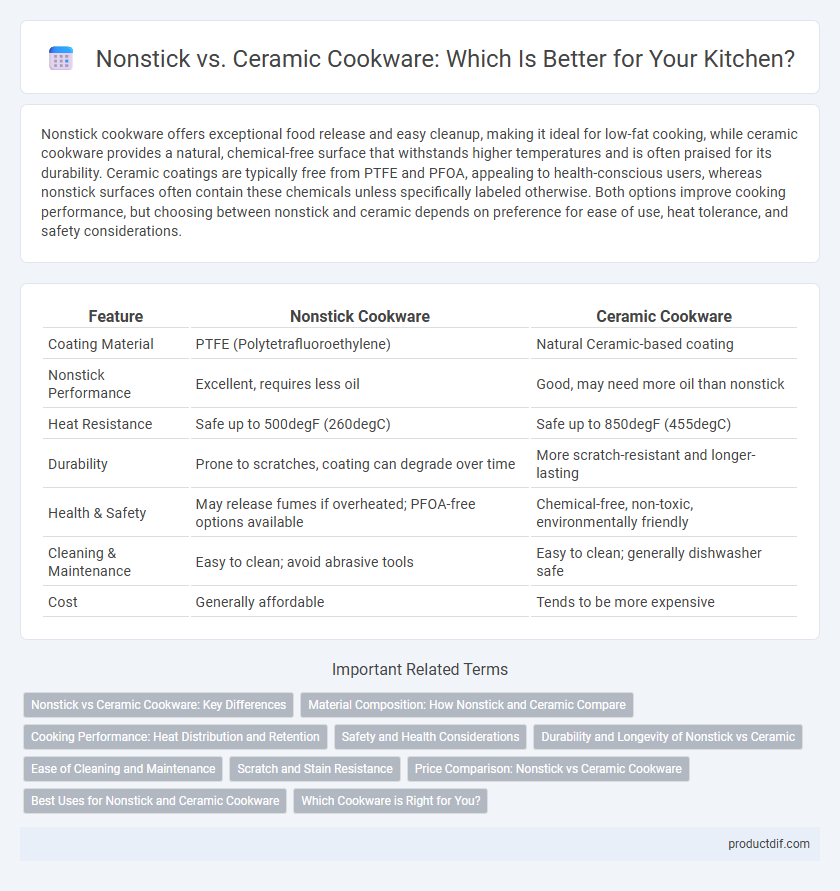Nonstick cookware offers exceptional food release and easy cleanup, making it ideal for low-fat cooking, while ceramic cookware provides a natural, chemical-free surface that withstands higher temperatures and is often praised for its durability. Ceramic coatings are typically free from PTFE and PFOA, appealing to health-conscious users, whereas nonstick surfaces often contain these chemicals unless specifically labeled otherwise. Both options improve cooking performance, but choosing between nonstick and ceramic depends on preference for ease of use, heat tolerance, and safety considerations.
Table of Comparison
| Feature | Nonstick Cookware | Ceramic Cookware |
|---|---|---|
| Coating Material | PTFE (Polytetrafluoroethylene) | Natural Ceramic-based coating |
| Nonstick Performance | Excellent, requires less oil | Good, may need more oil than nonstick |
| Heat Resistance | Safe up to 500degF (260degC) | Safe up to 850degF (455degC) |
| Durability | Prone to scratches, coating can degrade over time | More scratch-resistant and longer-lasting |
| Health & Safety | May release fumes if overheated; PFOA-free options available | Chemical-free, non-toxic, environmentally friendly |
| Cleaning & Maintenance | Easy to clean; avoid abrasive tools | Easy to clean; generally dishwasher safe |
| Cost | Generally affordable | Tends to be more expensive |
Nonstick vs Ceramic Cookware: Key Differences
Nonstick cookware features a synthetic polymer coating, often PTFE-based, offering superior food release and easy cleaning, while ceramic cookware utilizes a silica-based coating that provides a natural, chemical-free nonstick surface. Nonstick pans tend to have better heat conduction and require less oil, whereas ceramic pans can withstand higher temperatures but may wear out faster over time. Choosing between nonstick and ceramic cookware depends on cooking habits, durability preferences, and concerns about chemical coatings.
Material Composition: How Nonstick and Ceramic Compare
Nonstick cookware typically features a synthetic polymer coating such as polytetrafluoroethylene (PTFE), known for its exceptional release properties and durability. Ceramic cookware uses a silica-based inorganic coating derived from sand, offering a chemically inert and naturally non-toxic surface. While nonstick coatings excel in slickness and heat resistance, ceramic surfaces provide greater scratch resistance and withstand higher cooking temperatures without degradation.
Cooking Performance: Heat Distribution and Retention
Nonstick cookware offers superior heat distribution thanks to its aluminum core, ensuring even cooking and preventing hot spots. Ceramic cookware excels in heat retention, maintaining consistent temperatures for longer periods, which is ideal for slow cooking techniques. Both materials provide efficient cooking performance, but nonstick pans heat quickly while ceramic retains warmth effectively.
Safety and Health Considerations
Nonstick cookware often contains PTFE coatings that can release harmful fumes at high temperatures, posing respiratory risks. Ceramic cookware, made from natural materials without synthetic chemicals, offers a safer alternative with minimal risk of toxic exposure. Both types require proper use and care to maintain their safety and health benefits.
Durability and Longevity of Nonstick vs Ceramic
Nonstick cookware typically features a PTFE coating that offers durability but can degrade with high heat and metal utensils, reducing its lifespan to around 3-5 years. Ceramic cookware boasts a harder surface that resists scratches and can last longer, often exceeding 5 years with proper care, although it may be more prone to chipping. Both types require gentle cleaning and careful use to maximize longevity, but ceramic generally provides more durable performance over time.
Ease of Cleaning and Maintenance
Nonstick cookware offers superior ease of cleaning due to its smooth, slippery surface that prevents food from sticking, requiring minimal scrubbing and less oil for cooking. Ceramic cookware, while naturally nonstick and free of synthetic coatings, may require more careful maintenance to avoid chipping and often needs gentle cleaning to preserve its performance. Both types benefit from hand washing and avoiding abrasive materials, but nonstick pans typically allow for quicker, hassle-free cleanup compared to ceramic options.
Scratch and Stain Resistance
Nonstick cookware typically features a Teflon coating that offers moderate scratch resistance but can be easily damaged by metal utensils, while ceramic cookware boasts a harder surface that is more resistant to scratches and abrasions. In terms of stain resistance, ceramic cookware excels due to its non-porous surface that resists discoloration and staining even after prolonged use. Maintaining both types with proper care, such as using silicone or wooden tools, can extend their lifespan and preserve their appearance.
Price Comparison: Nonstick vs Ceramic Cookware
Nonstick cookware typically costs less than ceramic cookware, with prices ranging from $20 to $80 for standard sets, whereas ceramic options usually start around $40 and can exceed $150 depending on brand and quality. Nonstick pans often use PTFE coatings, which contribute to their lower price point compared to ceramic's more natural, silicon-based coating that demands higher manufacturing costs. Consumer reviews highlight that while nonstick sets offer affordability and ease of use, ceramic cookware's durability justifies its premium price for those seeking long-term investment.
Best Uses for Nonstick and Ceramic Cookware
Nonstick cookware excels in cooking delicate foods such as eggs, pancakes, and fish, where easy release and minimal oil usage are essential for perfect results. Ceramic cookware is ideal for high-heat searing, roasting, and slow cooking, providing excellent heat retention and a non-toxic, environmentally friendly surface. Choosing between nonstick and ceramic depends on cooking style, with nonstick favored for low to medium heat and ceramic preferred for versatility and durability at higher temperatures.
Which Cookware is Right for You?
Nonstick cookware offers easy food release and simple cleanup, making it ideal for low-fat cooking and everyday use. Ceramic cookware provides a chemical-free, environmentally friendly option with excellent heat distribution and durability, perfect for high-heat searing and oven use. Choosing between nonstick and ceramic depends on your cooking style, health preferences, and maintenance willingness to ensure long-lasting kitchen performance.
Nonstick vs Ceramic Infographic

 productdif.com
productdif.com